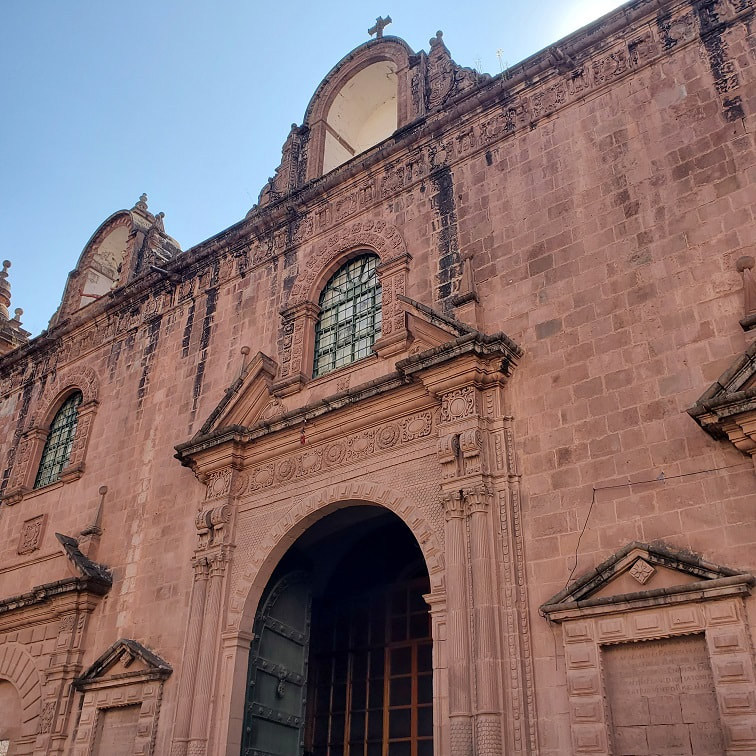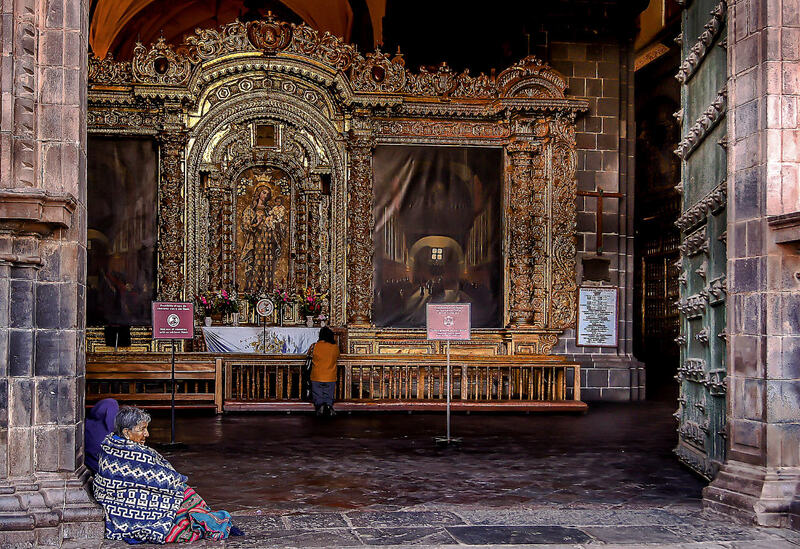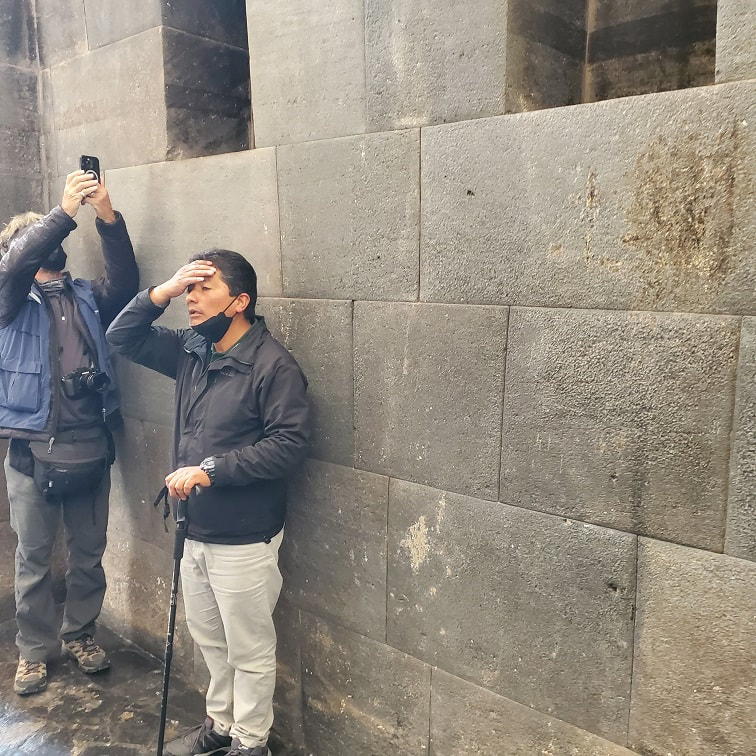|
This was our last full day of the expedition! We started off at 9am with a half-day tour of Cusco. It was a short walk from the hotel to the Cusco Cathedral. The Cathedral of Cusco or Cathedral Basilica of the Virgin of the Assumption (1668) is the main temple of the city of Cusco, in Peru and houses the headquarters of the Archdiocese of Cusco. The Cathedral Basilica of Cusco, together with the Triunfo temple make up the Cathedral Complex, it is located in the northeast sector of the current Plaza de Armas of Cusco. In the place that, during the Inca period, was occupied by both the Suntor Wassi (lit. "Government House") and the Kisoarkancha or Palace of the eighth Inca Viracocha. The complex occupies an area of 3,920 square meters and is the most important religious monument in the Historic Center of Cusco. Since 1972 the temple has been part of the Monumental Zone of Cusco declared as a Historical Monument of Peru. Also, in 1983, being part of the historic center of the city of Cusco, it is part of the central zone declared by UNESCO as World Heritage Site. The Incas built the temple known as Kiswarkancha on the main square in Cusco. It was the Inca palace of Viracocha, ruler of the Kingdom of Cusco around a century before the Spanish colonists arrived. The aboriginal name of this city was Qusqu. Although it was used in Quechua, its origin has been found in the Aymara language. The word itself originated in the phrase qusqu wanka ("Rock of the owl"), attending to the foundational myth of the Ayar siblings.[4]Near to the Kiswarkancha was the Suntur Wasi, an armoury and heraldry centre for the Inca royalty.When the Spanish conquistadores arrived in Cuzco, they decided to take down the temple and build their Christian cathedral in that prominent site. Next stop, the Coricancha Temple, the Temple of the Sun. This was the most sacred space in the Inca Empire. Originally named Intikancha or Intiwasi,it was dedicated to Inti, and is located at the former Inca capital of Cusco. Most of the temple was destroyed after the 16th-century war with the Spanish conquistadors, as settlers also took it apart to build their own churches and residences. Much of its stonework was used as the foundation for the seventeenth-century Santo Domingo Convent. It was built after the 1650 earthquake destroyed the first Dominican convent. To construct Coricancha, the Inca used ashlar masonry, building from the placement of similarly sized cuboid stones that they had cut and shaped for this purpose. The use of ashlar masonry made the temple much more difficult to construct, as the Inca did not use any stone with a slight imperfection or break. By choosing this masonry type, the Inca intentionally demonstrated the importance of the building through the extent of the labor necessary to build the structure. Pachakutiq Inca Yupanqui rebuilt Cusco and the House of the Sun, enriching it with more oracles and edifices, and adding plates of fine gold. He provided vases of gold and silver for the Mama-cunas, nuns or cloistered women, to use in the veneration services. Finally, he took the bodies of the seven deceased Incas and adorned them with masks, head-dresses, medals, bracelets, and sceptres of gold, placing them on a golden bench. The walls were once covered in sheets of gold, and the adjacent courtyard was filled with golden statues. Spanish reports tell of an opulence that was "fabulous beyond belief". When the Spanish in 1533 required the Inca to raise a ransom in gold for the life of their leader Atahualpa, most of the gold was collected from Coricancha. The Spanish colonists built the Convent of Santo Domingo on the site, demolishing the temple and using its foundations for the cathedral. They also used parts of the building for other churches and residences. Construction took most of a century. This is one of numerous sites where the Spanish incorporated Inca stonework into the structure of a colonial building. Major earthquakes severely damaged the church, but the Inca stone walls, built out of huge, tightly interlocking blocks of stone, still stand due to their sophisticated stone masonry. Learn more from this article from The Gaurdian, "Coricancha, the Inca's temple of the sun: a history of cities in 50 buildings." In March of 1533 Martin Bueno and Pedro Martuide Moguer, illiterate soldiers and Juan Zarate, notarary — traveled to Cuzco at Atahualpa and Pizzaro's request to encourage the removal of gold. See Cuzco History for more. The Spanairds went to the Qoricancha and removed the 700 gold plating around its outside walls. Each 2.5ft in length and weighing 4.5lbs — about 9 years of wages each. The spanairds returned to Pizarro with 178 loads of gold.5 They also collected a 190lbs gold altar, and 120lbs gold fountain. From travel blog by Andy Roscoe. We then traveled to the nearby Sacsayhuaman Fortress. The Sacsayhuaman archaeological site is located approximately 2 kilometers, or 1.25 miles, from the Cusco Town Square at an altitude of 12, 140 feet above sea level. It is a very large archaeological site at over 3,000 hectares on a hill that is surrounded by mountains. Sacsayhuaman is the highest point in Cusco. Sacsayhuaman is arguably the most impressive Inca Ruin that remains standing today. It was originally built by the people that inhabited Cusco before the Inca, the Killke culture. Construction by the Killke culture was started in 1100 CE. Once the Inca culture inhabited the area the Inca expanded on the construction of Sacsayhuaman. The Sacsayhuamán complex is a marvel of engineering with some of the largest blocks ever found in Incan construction pieced together so tightly that mortar was not necessary. The remaining site is what is left today from a much larger fortress that once was. There are three large sections of the remaining walls, with a large square and rectangular stones that are perfectly stacked on top of each other. Each of the stones is different in size and shape making each stone placed with a custom fit. No one truly knows the original purpose behind Sacsayhuaman, however, some of the theories maintain that it served as an Inca fortress or a ceremonial center. Read more. On the way back to the hotel, we stopped off at Sulca Textiles. "The Sulca Textile House Museum currently revalues, preserves, elaborates, innovates and disseminates the fabric made with the specialized knowledge and textile techniques that influenced ancient Peru, this is the family legacy to the world." After luch at the hotel Merle and I set out for the Museo Machu Picchu and got lost as we wandered through the hilly city in the thin air and hot sun.
0 Comments
Leave a Reply. |
Just the highlights and headlines...
Archives
January 2023
Categories |





















































 RSS Feed
RSS Feed